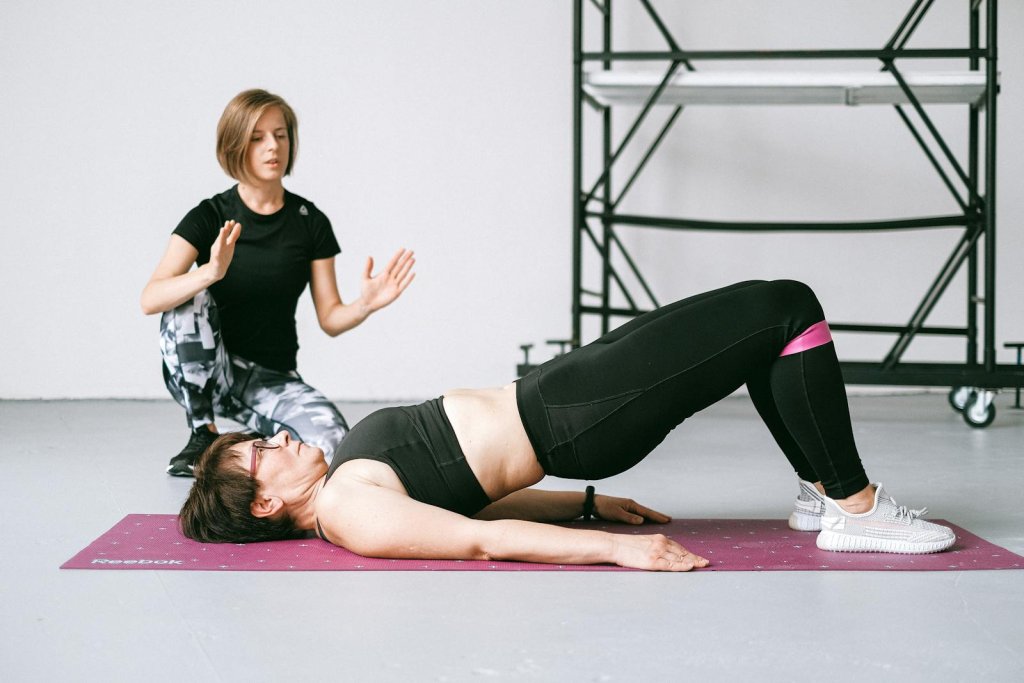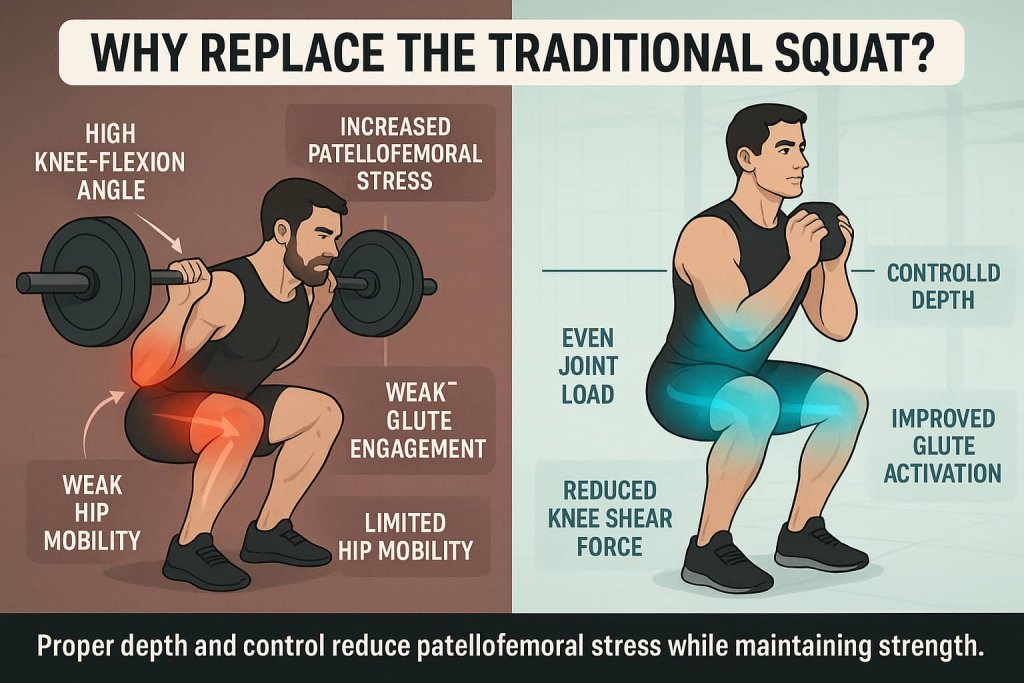If squats cause knee pain or discomfort, you can still build strong, powerful legs using safer, joint-friendly alternatives.
Many people experience knee strain due to poor mobility, weak stabilizers, or past injuries — but that doesn’t mean leg day is over. Learning smart squat alternatives helps you strengthen the same muscles (quads, glutes, hamstrings, and core) with less joint stress.

These movements mimic squat mechanics while improving stability, balance, and flexibility — ideal for home or gym workouts. Always consult a certified trainer or physiotherapist if pain persists.
Why Replace the Traditional Squat?
While squats are a classic lower-body exercise, they aren’t ideal for everyone. Common issues include:
- Knee or patellar tendon pain
- Limited ankle or hip mobility
- Back strain from poor posture or loading
- Equipment limitations (no squat rack or barbell)

Evidence indicates that patellofemoral joint stress increases with greater knee flexion during squats; for individuals with patellofemoral pain or poor hip control, shallower or modified variations may be more comfortable, while deep squats can still be safe for healthy lifters when technique is sound.
Key Muscles Targeted
All squat alternatives primarily engage:
- Quadriceps – for leg extension and power
- Gluteus Maximus & Medius – for hip drive and stability
- Hamstrings – for balance and joint control
- Core – for posture and spinal support
12 Best Squat Alternatives
These squat alternatives target your quads, glutes, and hamstrings without stressing your knees or lower back.
Each movement mimics the benefits of squats while improving strength, stability, and mobility safely.
1. Bulgarian Split Squat
Why it works:
A powerful unilateral exercise that strengthens the quads and glutes while improving hip stability and balance. By isolating one leg at a time, it reduces spinal load and evenly corrects muscular imbalances common with bilateral squats.
Muscles worked:
Quadriceps, glutes, hamstrings, and core.
How to do it:
- Stand about two feet in front of a bench or step.
- Place your rear foot on the bench (top of the foot or toes).
- Lower your body until your front thigh is nearly parallel to the floor, keeping the knee over the ankle.
- Push through your front heel to return to the starting position.
Trainer Tip:
Maintain an upright torso and control the descent. Avoid letting the front knee collapse inward.
2. Step-Up (Box or Bench)
Why it works:
A functional, knee-friendly exercise that mimics everyday movements like climbing stairs. It strengthens the quads and glutes while promoting balance and unilateral coordination.
Muscles worked:
Quadriceps, glutes, calves, and core.
How to do it:
- Stand in front of a sturdy box or bench about knee height.
- Step one foot fully onto the surface, driving through the heel.
- Bring the opposite leg up to stand tall, then lower with control.
Trainer Tip:
Focus on using your lead leg only — avoid pushing off the back leg.
3. Wall Sit
Why it works:
A static, joint-friendly movement that builds muscular endurance in the quads and strengthens the core without dynamic pressure on the knees.
Muscles worked:
Quadriceps, glutes, and core stabilizers.
How to do it:
- Stand with your back against a wall and feet shoulder-width apart.
- Slide down until thighs are parallel to the floor and knees are above ankles.
- Hold this position for 30–60 seconds.
Trainer Tip:
Don’t press knees forward past toes. For added challenge, hold a dumbbell or medicine ball.
4. Glute Bridge
Why it works:
Activates the glutes and hamstrings effectively while minimizing knee stress. Ideal for those with patellar pain or limited squat mobility.
Muscles worked:
Glutes, hamstrings, and core.
How to do it:
- Lie on your back with knees bent and feet flat on the ground.
- Engage your core and drive through your heels to lift your hips upward.
- Squeeze your glutes at the top before slowly lowering.
Trainer Tip:
Avoid arching your lower back. Keep ribs down and glutes engaged throughout.
5. Reverse Lunge
Why it works:
Places less shear force on the knees than forward lunges, making it ideal for those with joint sensitivity. Builds single-leg strength and balance.
Muscles worked:
Quads, glutes, hamstrings, and calves.
How to do it:
- Stand tall, then step one leg backward into a lunge.
- Lower your back knee toward the floor without touching it.
- Push through your front heel to return to standing.
Trainer Tip:
Keep your front knee aligned with your toes and torso upright.
6. Lateral Lunge
Why it works:
Improves hip mobility and strengthens muscles in the frontal plane — often neglected in traditional squats. Helps prevent knee instability.
Muscles worked:
Glutes, adductors, quads, and core.
How to do it:
- Stand tall with feet wide apart.
- Step to one side, bending the working knee while keeping the other leg straight.
- Push hips back, then drive through your heel to return.
Trainer Tip:
Keep your working foot flat and chest lifted; don’t lean excessively forward.
7. Heel-Elevated Goblet Squat
Why it works:
A modification that improves ankle mobility, allowing a more upright torso and deeper quad activation with less knee tension.
Muscles worked:
Quadriceps, glutes, calves, and core.
How to do it:
- Hold a dumbbell or kettlebell at chest height.
- Place heels on a small wedge, weight plate, or slant board.
- Squat down under control until thighs are parallel.
- Push through your heels to return.
Trainer Tip:
Focus on a slow, controlled descent. Avoid excessive forward lean.
8. TRX Assisted Squat
Why it works:
TRX handles provide balance support, allowing for deeper squats and better alignment while reducing knee and spinal stress.
Muscles worked:
Quads, glutes, hamstrings, and core.
How to do it:
- Grab TRX handles and stand with feet shoulder-width apart.
- Lean back slightly to keep tension in the straps.
- Lower into a squat, maintaining tension, then drive through your heels to stand.
Trainer Tip:
Use your legs, not your arms, to lift — keep the pull gentle and supportive.
9. Leg Press (Machine)
Why it works:
Offers controlled loading of the quads and glutes with adjustable resistance, making it safer for knees and lower back compared to free-weight squats.
Muscles worked:
Quadriceps, glutes, hamstrings.
How to do it:
- Sit in the leg press machine with your back supported.
- Place feet shoulder-width apart on the platform.
- Lower the weight until knees are at 90°, then press back up.
Trainer Tip:
Avoid locking your knees and keep your lower back flat on the seat.
10. Box Squat
Why it works:
Trains proper squat depth, promotes safe hip hinging, and reduces the risk of knee strain. Perfect for beginners learning squat mechanics.
Muscles worked:
Quads, glutes, and hamstrings.
How to do it:
- Stand in front of a box or bench slightly below knee height.
- Hinge at the hips and lower down until you touch the box lightly.
- Drive through your heels to return to standing.
Trainer Tip:
Don’t drop onto the box — control every inch of movement.
11. Cable Pull-Through
Why it works:
Reinforces the hip-hinge pattern while sparing the knees. Excellent for glute and hamstring development.
Muscles worked:
Glutes, hamstrings, and erector spinae.
How to do it:
- Attach a rope handle to a low cable pulley.
- Stand facing away, holding the rope between your legs.
- Hinge at your hips, keeping a neutral spine.
- Drive hips forward to return upright.
Trainer Tip:
Avoid using your arms — focus on glute contraction to initiate the movement.
12. Seated Leg Extension
Why it works:
Isolates the quadriceps and helps strengthen knee-supporting muscles without axial loading. Commonly used in rehab and strength-building programs.
Muscles worked:
Quadriceps.
How to do it:
- Sit on the leg extension machine with knees aligned to the pivot point.
- Extend your legs fully, then lower slowly under control.
- Repeat for the desired reps.
Trainer Tip:
Hold the top position for 1–2 seconds for maximal quad engagement.
Common Mistakes to Avoid
- Allowing knees to cave inward (valgus collapse)
- Rushing reps without control
- Ignoring hip and ankle mobility
- Overloading weights too soon
- Neglecting glute activation before workouts
Safety Tips
- Warm up with light cardio and dynamic stretches (5–10 minutes).
- Focus on pain-free range of motion.
- Prioritize form over load.
- If discomfort persists, consult a physical therapist.
FAQs
1. Are squat alternatives as effective as regular squats?
Yes — when performed correctly, many alternatives like Bulgarian split squats and step-ups activate similar muscle groups.
2. Which squat alternative is best for knee pain?
Reverse lunges and wall sits reduce forward knee travel and are safer for sensitive joints.
3. Can I still grow my legs without squatting?
Absolutely. Progressive overload through exercises like leg press, step-ups, and goblet squats ensures growth.
4. How often should I train legs if avoiding squats?
2–3 sessions per week, allowing 48 hours recovery between heavy sessions.
5. Are squat alternatives good for beginners?
Yes, especially TRX squats and glute bridges — they build strength and control before advancing.
Conclusion
You don’t have to squat to build strong, defined legs. The right squat alternatives target your quads, glutes, and hamstrings — safely and effectively — without putting pressure on your knees.
Start with 3–4 of these exercises, focus on good form, and progress gradually. Strong legs come from smart training, not just heavy squats.
References
- Squat Biomechanics and Patellofemoral Stress (2024, open access) — PF joint stress increases with deeper knee flexion; moderate depths or alternative patterns may help sensitive knees.
https://pmc.ncbi.nlm.nih.gov/articles/PMC10987311/ - Are Deep Squats Inherently Risky? Scoping Review (Frontiers, 2024) — Deep squats aren’t automatically harmful in healthy populations; context and technique matter.
https://www.frontiersin.org/articles/10.3389/fspor.2024.1477796/full - Joint Kinetics of Single-Leg Squat and Lunges (2015, open access) — Comparative kinetics to guide safer lunge and split-squat selections.
https://pmc.ncbi.nlm.nih.gov/articles/PMC4641539/ - Squat vs Leg Press: EMG and Kinematics (2021, open access) — Similar quadriceps activation; leg press offers machine-controlled depth and alignment for joint-sensitive lifters.
https://pmc.ncbi.nlm.nih.gov/articles/PMC8374053/ - Box Squat vs Traditional/Powerlifting Squat (JSCR, 2012) — Biomechanical comparison informing box-squat technique and loading as a controlled alternative.
https://journals.lww.com/nsca-jscr/fulltext/2012/07000/a_biomechanical_comparison_of_the_traditional.10.aspx
